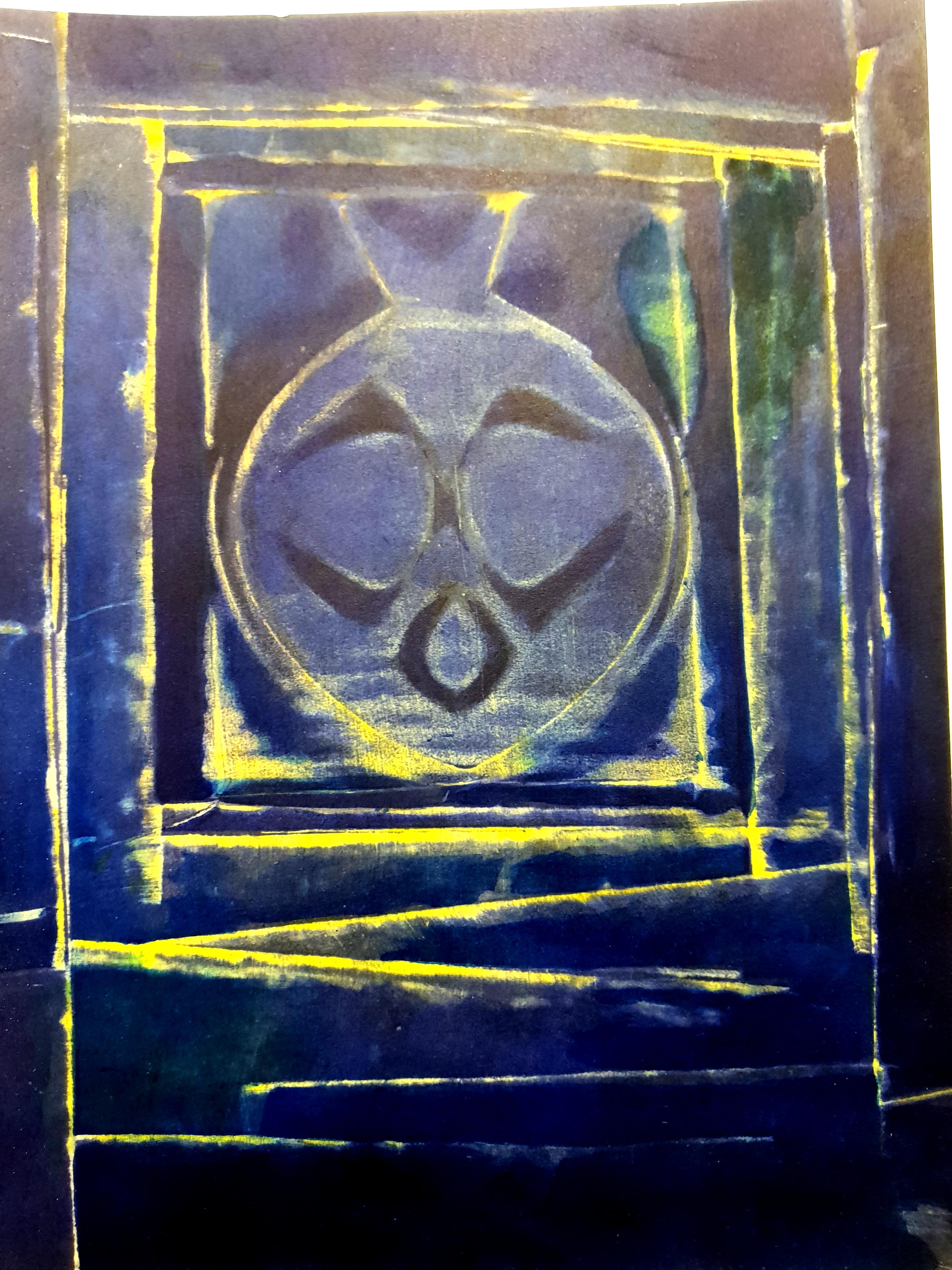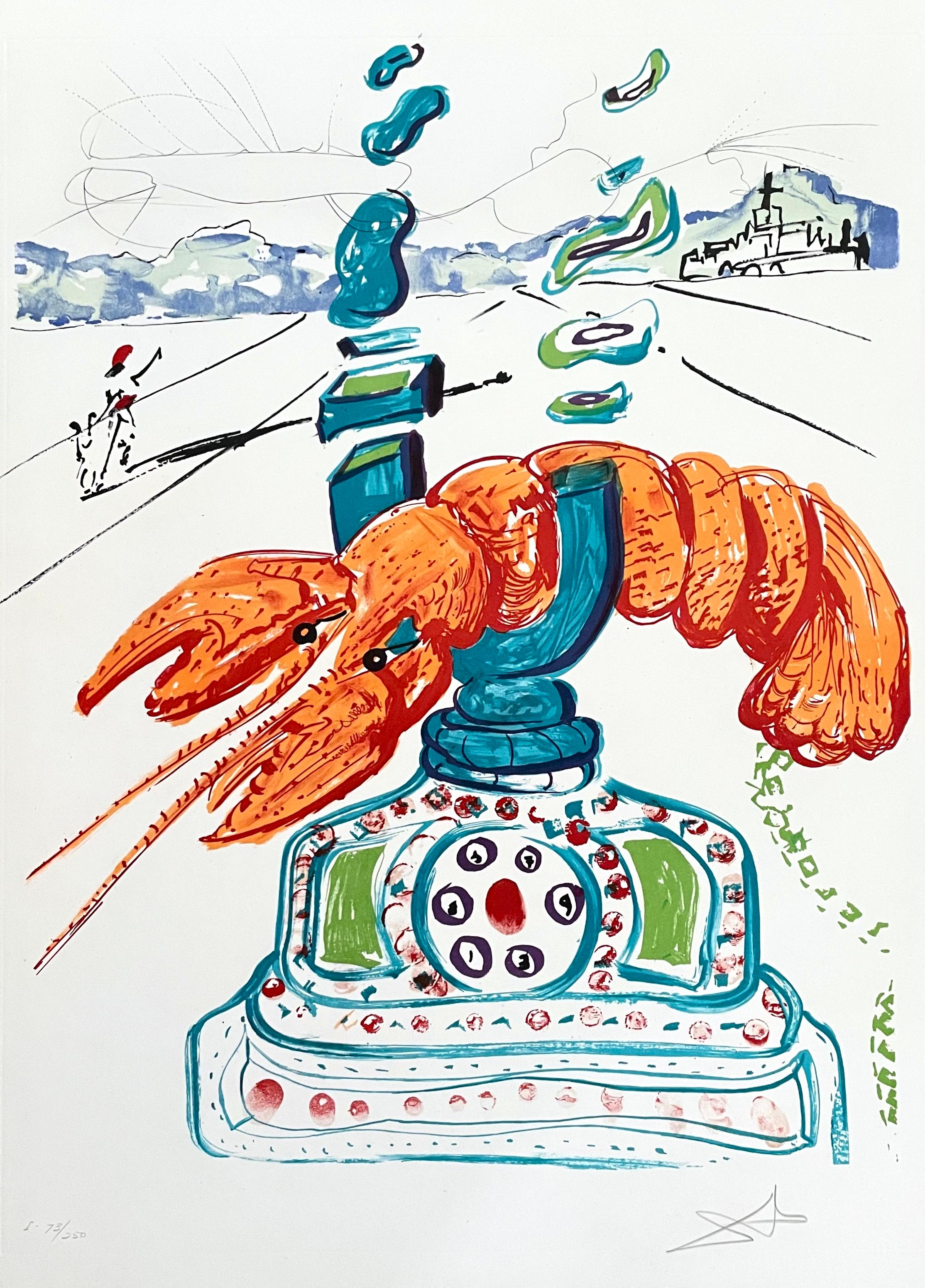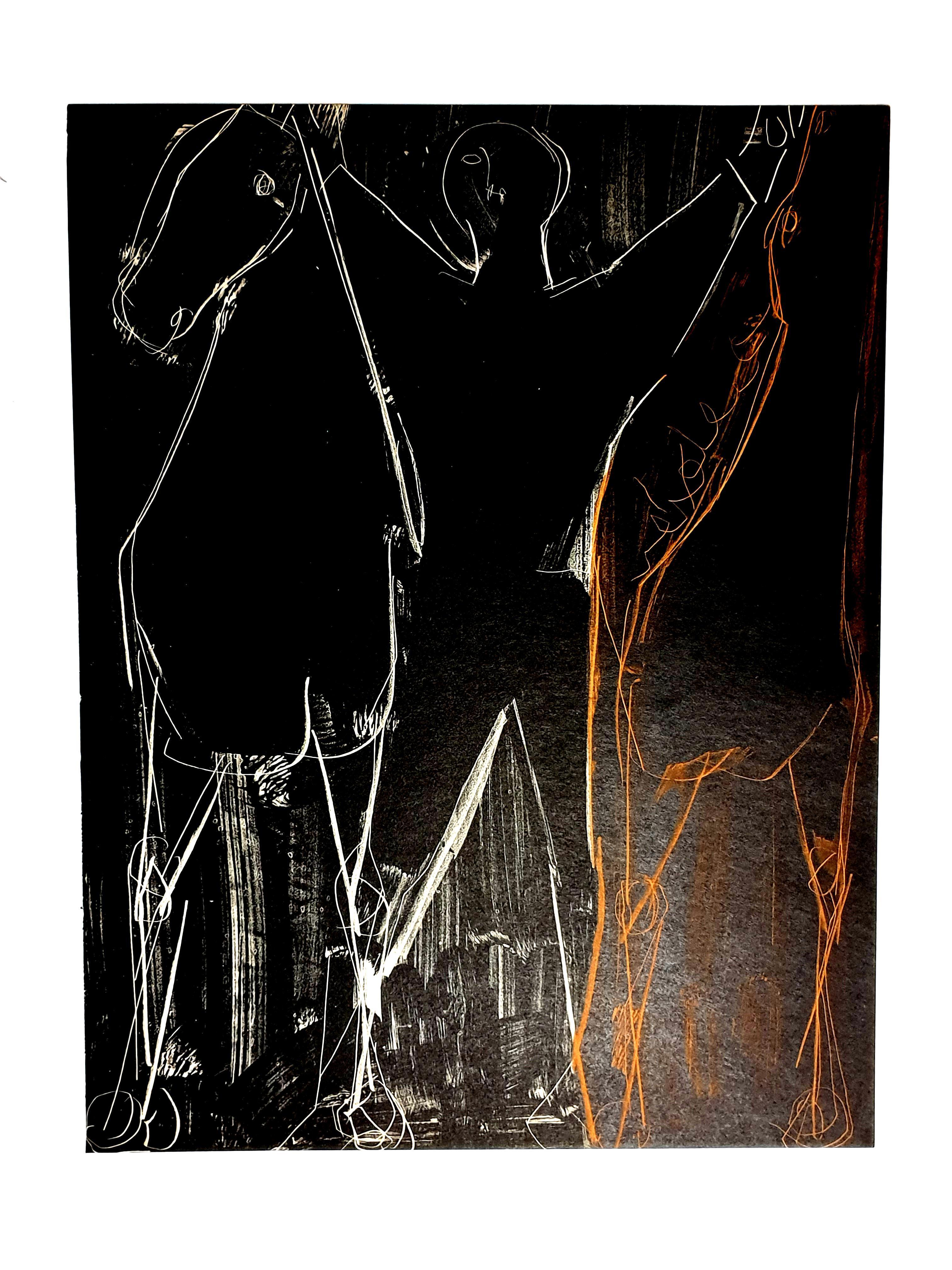Items Similar to Horses in a Mythological Landscape - Lithograph
Want more images or videos?
Request additional images or videos from the seller
1 of 12
Giorgio De ChiricoHorses in a Mythological Landscape - Lithograph
About the Item
Giorgio de CHIRICO
Horses in a Mythological Landscape, c. 1955
Lithograph and stencil (Jacomet workshop)
Printed signature in the plate
On light vellum 48 x 38 cm (c. 19 x 15 in)
Very good condition, light defects at the edge of the sheet
- Creator:Giorgio De Chirico (1888-1978, Italian)
- Dimensions:Height: 18.9 in (48 cm)Width: 14.97 in (38 cm)
- Medium:
- Movement & Style:
- Period:
- Condition:
- Gallery Location:Paris, FR
- Reference Number:1stDibs: LU464310031422
About the Seller
4.9
Platinum Seller
These expertly vetted sellers are 1stDibs' most experienced sellers and are rated highest by our customers.
Established in 2010
1stDibs seller since 2016
3,250 sales on 1stDibs
Typical response time: 1 hour
- ShippingRetrieving quote...Ships From: Paris, France
- Return PolicyA return for this item may be initiated within 7 days of delivery.
More From This SellerView All
- Surrealist Dream : Couple of Roosters - Original lithograph (Spies #p. 438)By Max ErnstLocated in Paris, FRMax Ernst (1891-1976) Surrealist Dream : Couple of Roosters, 1970 Original color lithograph Printed signature in the plate On Arches vellum 33.5 × 61 cm (c. 13 x 24 in) REFERENCES...Category
1970s Surrealist Animal Prints
MaterialsLithograph
- Dancing Griffin - LithographBy Jean CocteauLocated in Paris, FRJean COCTEAU Dancing Griffin Lithograph Printed signature in the plate On vellum : 50 x 36 cm (c. 20 x 14 in) Bears the stamp of the artist Excellent conditionCategory
Mid-20th Century Surrealist Animal Prints
MaterialsLithograph
- Tribute to Mozart : Firebird - Original handsigned lithographBy CorneilleLocated in Paris, FRCorneille Tribute to Mozart : Firebird, 1991 Original lithograph Handsigned Numbered EA /30 On vellum 50 x 65 cm (c. 20 x 26 inch) Excellent conditionCategory
1980s Surrealist Animal Prints
MaterialsLithograph
- The Bug - Original handsigned lithographBy CorneilleLocated in Paris, FRCorneille The Bug, 1999 Original lithograph Handsigned Numbered EA /25 On vellum 63 x 46 cm (c. 25 x 18 inch) Excellent conditionCategory
1990s Surrealist Animal Prints
MaterialsLithograph
- Butterfly suite : Auvergne - lithograph - Tall size, 1969By (after) Salvador DaliLocated in Paris, FRafter Salvador DALI (1904-1969) France : Auvergne, 1969 Lithograph and heliogravure Printed signature in the plate bottom right Tall model, from the 700 unumbered edition Printed in...Category
1960s Surrealist Animal Prints
MaterialsPhotogravure, Lithograph
- Surrealist Horse and Rider - Handsigned lithographBy Frédéric BouchéLocated in Paris, FRFrederic BOUCHE Surrealist Horse and Rider Original lithograph Handsigned in pencil Numbered / 125 copies On Japan paper 65 x 50 cm (c. 26 x 20 in) Excellent conditionCategory
Late 20th Century Surrealist Animal Prints
MaterialsLithograph
You May Also Like
- (after) Max Ernst - Blue Bird - StencilBy (after) Max ErnstLocated in Collonge Bellerive, Geneve, CHMax Ernst (after) - Blue Bird - Stencil Published in the deluxe art review, XXe Siecle, 1958 Dimensions: 32 x 25 cm Publisher: G. di San Lazzaro. Max Ernst was born in Bruhl, a place near Cologne, in Germany. He was raised in a strict Catholic family, and both of his parents were disciplinarians who were dedicated to training their children into God-fearing and talented individuals. Although his father was deaf, Ernst learned so much from him, particularly when it comes to painting. In fact, much of his early years were lived under the inspiration of his father who was also a teacher. He was the one who introduced painting to Ernst at an early age. In 1914, Ernst attended the University of Bonn where he studied philosophy. However, he eventually dropped out of school because he was more interested in the arts. He claimed that his primary sources of interest included anything that had something to do with painting. Moreover, he became fascinated with psychology, among other subjects in school. Primarily, Ernst's love for painting was the main reason why he became deeply interested with this craft and decided to pursue it later on in his life. During his early years, he became familiar with the works of some of the greatest artists of all time including Claude Monet, Paul Cezanne and Vincent van Gogh. He was also drawn to themes such as fantasy and dream imagery, which were among the common subjects of the works of Giorgio de Chirico. During World War I, Ernst was forced to join the German Army, and he became a part of the artillery division that exposed him greatly to the drama of warfare. A soldier in the War, Ernst emerged deeply traumatized and highly critical of western culture. These charged sentiments directly fed into his vision of the modern world as irrational, an idea that became the basis of his artwork. Ernst's artistic vision, along with his humor and verve come through strongly in his Dada and Surrealists works; Ernst was a pioneer of both movements. It was Ernst's memories of the war and his childhood that helps him create absurd, yet interesting scenes in his artworks. Soon, he took his passion for the arts seriously when he returned to Germany after the war. With Jean Arp, a poet and artist, Ernst formed a group for artists in Cologne. He also developed a close relationship with fellow artists in Paris who propagated Avant-Garde artworks. In 1919, Ernst started creating some of his first collages, where he made use of various materials including illustrated catalogs and some manuals that produced a somewhat futuristic image. His unique masterpieces allowed Ernst to create his very own world of dreams and fantasy, which eventually helped heal his personal issues and trauma. In addition to painting and creating collages, Ernst also edited some journals. He also made a few sculptures that were rather queer in appearance. In 1920s, influenced by the writings of psychologist Sigmund Freud, the literary, intellectual, and artistic movement called Surrealism sought a revolution against the constraints of the rational mind; and by extension, they saw the rules of a society as oppressive. Surrealism also embraces a Marxist ideology that demands an orthodox approach to history as a product of the material interaction of collective interests, and many renown Surrealism artists later on became 20th century Counterculture symbols such as Marxist Che Guevara. In 1922 Ernst moved to Paris, where the surrealists were gathering around Andre Breton. In 1923 Ernst finished Men Shall Know Nothing of This, known as the first Surrealist painting. Ernst was one of the first artists who apply The Interpretation of Dreams by Freud to investigate his deep psyche in order to explore the source of his own creativity. While turning inwards unto himself, Ernst was also tapping into the universal unconscious with its common dream imagery. Despite his strange styles, Ernst gained quite a reputation that earned him some followers throughout his life. He even helped shape the trend of American art during the mid-century, thanks to his brilliant and extraordinary ideas that were unlike those of other artists during his time. Ernst also became friends with Peggy Guggenheim, which inspired him to develop close ties with the abstract expressionists. When Ernst lived in Sedona, he became deeply fascinated with the Southwest Native American navajo art. In fact, the technique used in this artwork inspired him and paved the way for him to create paintings that depicted this style. Thus, Ernst became a main figure of this art technique, including the rituals and spiritual traditions included in this form of art. Pollock, aside from the other younger generations of abstract expressionists, was also inspired by sand painting of the Southwest...Category
1950s Surrealist Animal Prints
MaterialsStencil
- St Georges et le Dragon, Surrealist Etching by Salvador Dali 1974By Salvador DalíLocated in Long Island City, NYSalvador Dali was a Spanish painter, printmaker, and sculptor heralded as the father of surrealism. This piece features the fabled story of Saint George gallantly slaying a dragon. T...Category
1960s Surrealist Animal Prints
MaterialsStencil, Etching
- Cybernetic Lobster Telephone (Imagination & Objects), Salvador DaliBy Salvador DalíLocated in Fairfield, CTArtist: Salvador Dali (1904-1989) Title: Cybernetic Lobster Telephone (Imagination & Objects of the Future Portfolio) Year: 1975 Medium: Lithograph ...Category
1970s Surrealist Landscape Prints
MaterialsLithograph, Mixed Media
- Marino Marini - Horses - Original LithographBy Marino MariniLocated in Collonge Bellerive, Geneve, CHMarino Marini - Horses - Original Lithograph 1951 Dimensions: 32 x 24 cm From the art review XXe siècle Unsigned and unumbered as issuedCategory
1950s Surrealist Animal Prints
MaterialsLithograph
- Jean Arp - Original LithographBy Jean ArpLocated in Collonge Bellerive, Geneve, CHJean Arp - Original Lithograph 1951 Dimensions: 32 x 24 cm From the art revue XXe siècle Unsigned and unumbered as issuedCategory
1950s Surrealist Animal Prints
MaterialsLithograph
- Max Ernst - Elektra - LithographBy Max ErnstLocated in Collonge Bellerive, Geneve, CHMax Ernst - Elektra Lithograph 1939 Dimensions: 32 x 24 cm Signed in the plate From XXe siècle Unsigned and unumbered as issuedCategory
1930s Surrealist Animal Prints
MaterialsLithograph
Recently Viewed
View AllMore Ways To Browse
15 In
Lithograph 19
Vintage Horse Art Prints
Retro Horse Print
Horse Plate
Lithograph Horses
Mythological Prints
Vintage Horse Lithograph
Vintage Horse Plate
Vintage Horse Plates
De Chirico Giorgio
Animal Framed Prints
Plate With Animals
Bird Prints Original
Butterfly Prints
Antique Animal Prints
Large Bird Prints
Large Prints Of Birds





